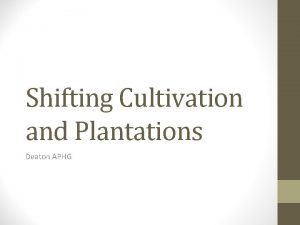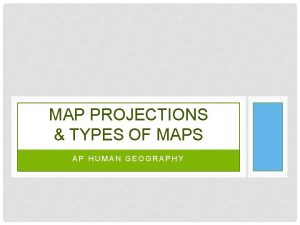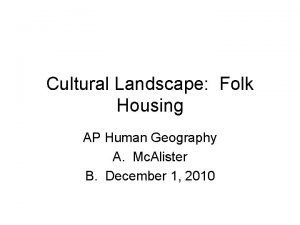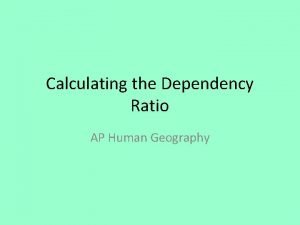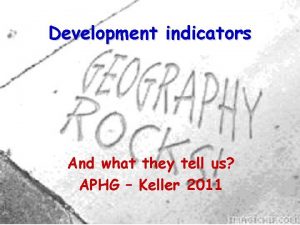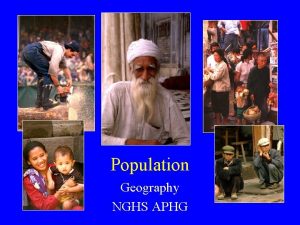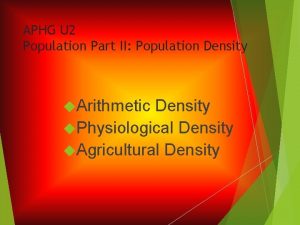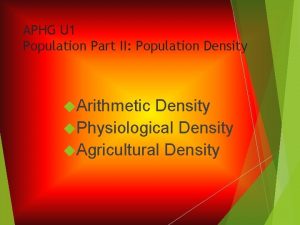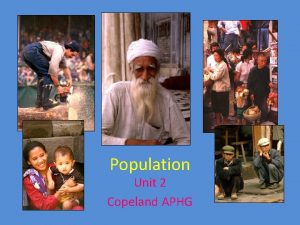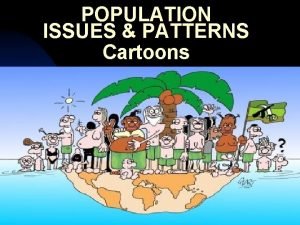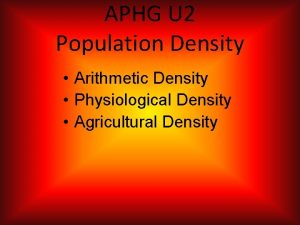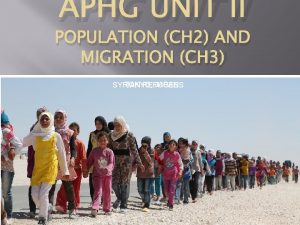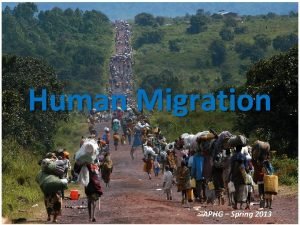Population APHG Population Key Issues Where is the






























































- Slides: 62

Population APHG

Population Key Issues Where is the world’s population distributed? Where has the world’s population increased? Why is population increasing at different rates in different countries? Why might the world face an overpopulation problem?

Population Terms Demography - The scientific study of population characteristics. Example: Birth Rates, Death Rates, Growth in More Developed –v- Developing. Overpopulation- The number of people in an area exceeds the capacity of the environment to support life at a decent standard of living. Density - The frequency with which something exists within a given unit of area

Distribution and Density


The World and the Top 10 – 2011 & 2016 2011 World China India United States Indonesia Brazil Pakistan Nigeria Bangladesh Russia Japan 6, 987, 000 1, 346, 000 1, 241, 000 312, 000 238, 000 198, 000 177, 000 162, 000 151, 000 143, 000 128, 000 2016 World China India United States Indonesia Brazil Pakistan Nigeria Bangladesh Russia Mexico 7, 418, 000 1, 378, 000 1, 329, 000 324, 000 259, 000 206, 000 203, 000 187, 000 163, 000 144, 000 129, 000

Population Growth Video

Population Distribution – Descriptions of locations on the Earth’s surface where individuals or groups (depending on the scale) live. Dot Map of World Population – On this map, one dot represents 100, 000 people

Countries are displayed by size of population rather than land area. Countries named have at least 50 million people.

World Population Clusters Two-thirds of the world’s population are concentrated in four regions: 1. East Asia (East China, Japan, S. Korea, Taiwan) - 1/5 of world population here 2. South Asia (India, Pakistan, Bangladesh) - bound by the Himalayas and a desert in Pakistan 3. Southeast Asia (Indonesia, Vietnam, Philippines) 4. Europe - population is concentrated in cities

East Asia

South Asia

Southeast Asia

Europe

North America

Ecumene The portion of Earth's surface occupied by permanent human settlement. Increased over time ¾ of world population lives on only 5% of the Earth’s surface

Population Distribution Densely populated regions Low lands Fertile soil Temperate climate Sparsely Populated Regions dry lands wet lands high lands cold lands

Population Why is population increasing at different rates in different countries? Arithmetic Density Physiological Density Agricultural Density

Density Arithmetic Density: The total number of people divided by the total land area. Examples: Juneau Alaska – largest city in the US – by land area (3, 225 Sq. Miles – 32, 660).


Density Physiological Density: The number of people per unit of area of arable land, which is land suitable for agriculture. Example: Singapore 982, 641.


Egypt’s population distribution is closely linked to the proximity of water. In the north, the population clusters along the Mediterranean and in the interior, along the banks of the Nile River. (2004)

Density Agricultural Density: The ratio of the number of farmers to the total amount of land suitable for agriculture. US –v- India

Demographic Transition Why is population increasing at different rates in different countries?

Stages in Classic 4 -Stage Demographic Transition Model (DTM) (Some books show a 3 -stage model; others mention a new 5 th stage)

Stage 1: “Pre-Industrial” High birth rates and high death rates (both about 40) Population growth very slow Agrarian (Agricultural) society High rates of communicable diseases Pop. increases in good growing years; declines in bad years (famine, diseases) No country or world region still in Stage One

Stage 2: “Early Industrial” High birth rates (over 30) but death rates decline (to about 20) Huge population growth. RNIs increase sharply (pop. explosion); growth rate increases throughout Stage Two Growth not from increase in births, but from decline in deaths MDCs = starts early 1800 s LDCs = starts after 1950 s

Stage 3: “Later Industrial” Birth rates decline sharply (to about 15) Death rates decline a bit more (to about 10 or less) Note growth still occurs, but at a reduced and declining rate MDCs = starts in late 1800 s LDCs = starts after 1980 s* * Or hasn’t started yet

Stage 4: “Post-Industrial” Birth rates and death rates both low (about 10) Population growth very low or zero MDCs = starts after 1970 s LDCs = hasn’t started yet Stage 5 (? ): Hypothesized (not in Classic DTM) Much of Europe now or soon in population decline as birth rates drop far below replacement level


Demographic Transition Model Draw it! Stages: 1 -5 and growth / CBR / CDR / NIR / Total Population Label the following countries: Afghanistan Germany Zambia Jordan Afghanistan Ukraine Uruguay Canada Mexico Hungary (Is that a country? ) Iraq

Population Pyramids Video

Dependency Ratio Dependency ratio The number of people under the age of 15 and over age 64, compared to the number of people active in the labor force. 0 -15 = Dependents 16 -64 = Workers 65+ = Dependents DR = Number of Dependents (0 -15 and 65+) X 100 Number of Working-age (16 -64) Example: Too many old people (Eastern Europe) or too many young people (Sub-Saharan Africa) can cause problems.


Population Pyramids A country’s stage in Demographic Transition gives it a distinctive population structure Also called Age-Sex Pyramids

Rapid Growth

Slow Growth

No Growth End of stage 4 Large number of “older people” Very small % of young people

Developing (poor) Relatively Developed (rich) What stage goes with each pyramid?




National Scale



Population Pyramids Video

Population Pyramids Baby Boom A cohort of individuals born in the United States between 1946 and 1964, which was just after World War II in a time of relative peace and prosperity. Echo Boom The generation born after the baby boomers; the "echo" of a generation boom (1980 s-1990 s)

Demographic Momentum Tendency for growing population to continue growing after a fertility decline bc of their young age distribution. This is important because once this happens a country moves to a different stage in the demographic transition model.

Why might the world face an overpopulation problem? Population Control

A Population Bomb? Thomas Malthus (1766 -1834, England) Population growing exponentially and resources growing linearly.

A Population Bomb? Esther Boserup (1910 - 1999) Population growth compels subsistence farmers to consider new farming approaches that produce enough food to take care of the additional people.

Five stage Model

Epidemiological Transition Model Epidemiological Transition Distinctive causes of death in each stage of the demographic transition.

Stage 1: Epidemics: Infectious and parasitic diseases, famine Ex: Black Plague

Stage 2: Receding Pandemics Ex: Cholera, Smallpox

Stage 3: Degenerative and humancreated disease Ex: Cardiovascular disease and Cancer

Stage 4: Delayed degenerative diseases Ex: Alzheimer's, Diabetes

Epidemiological Transition Model Stage 5? Re-emerging infectious and parasitic disease Ex: Malaria, TB, Swine Flu, AIDS, Ebola, Zeka

Slowing Growth How to change the J-Curve into an S-Curve: Educate Women Reduce Child Mortality Anti-Natalism Eugenics not an option Eugenics - the science of improving a human population by controlled breeding to increase the occurrence of desirable heritable characteristics. Example – Nazi Germany

Anti-Natalist Policies Anti-Natalism An attitude that asserts a negative value towards birth in order to limit population growth. Example Cold War communism in Eastern Europe China Population Pyramid Video 2

Pro-Natalist –v- Anti-Natalist Policies Pro-Natalism An attitude that encourages childbearing. Example: Japan, France and present day Russia Japan Video
 Chapter 4 section 1 population dynamics answer key
Chapter 4 section 1 population dynamics answer key Population ecology section 1 population dynamics
Population ecology section 1 population dynamics Population ecology chapter 4 answers
Population ecology chapter 4 answers Spatial association ap human geography
Spatial association ap human geography Suburbanization definition aphg
Suburbanization definition aphg Shifting cultivation ap human geography
Shifting cultivation ap human geography Goode homolosine projection ap human geography
Goode homolosine projection ap human geography What is outsourcing aphg
What is outsourcing aphg What is folk housing
What is folk housing Sex ratio ap human geography definition
Sex ratio ap human geography definition Remote sensing ap human geography
Remote sensing ap human geography Gis definition ap human geography
Gis definition ap human geography Sex ratio aphg
Sex ratio aphg Devolution aphg
Devolution aphg Chicago multiple nuclei model
Chicago multiple nuclei model Examples of prorupted states
Examples of prorupted states Harris and ullman multiple nuclei model example
Harris and ullman multiple nuclei model example Structuralist theory aphg
Structuralist theory aphg Long lot definition ap human geography
Long lot definition ap human geography Intensive subsistence agriculture aphg
Intensive subsistence agriculture aphg Key partners example business model canvas
Key partners example business model canvas Business model canvas tripadvisor
Business model canvas tripadvisor Population ecology section 1 population dynamics
Population ecology section 1 population dynamics Hình ảnh bộ gõ cơ thể búng tay
Hình ảnh bộ gõ cơ thể búng tay Slidetodoc
Slidetodoc Bổ thể
Bổ thể Tỉ lệ cơ thể trẻ em
Tỉ lệ cơ thể trẻ em Gấu đi như thế nào
Gấu đi như thế nào Tư thế worm breton
Tư thế worm breton Bài hát chúa yêu trần thế alleluia
Bài hát chúa yêu trần thế alleluia Các môn thể thao bắt đầu bằng tiếng nhảy
Các môn thể thao bắt đầu bằng tiếng nhảy Thế nào là hệ số cao nhất
Thế nào là hệ số cao nhất Các châu lục và đại dương trên thế giới
Các châu lục và đại dương trên thế giới Công của trọng lực
Công của trọng lực Trời xanh đây là của chúng ta thể thơ
Trời xanh đây là của chúng ta thể thơ Mật thư anh em như thể tay chân
Mật thư anh em như thể tay chân Phép trừ bù
Phép trừ bù độ dài liên kết
độ dài liên kết Các châu lục và đại dương trên thế giới
Các châu lục và đại dương trên thế giới Thể thơ truyền thống
Thể thơ truyền thống Quá trình desamine hóa có thể tạo ra
Quá trình desamine hóa có thể tạo ra Một số thể thơ truyền thống
Một số thể thơ truyền thống Cái miệng bé xinh thế chỉ nói điều hay thôi
Cái miệng bé xinh thế chỉ nói điều hay thôi Vẽ hình chiếu vuông góc của vật thể sau
Vẽ hình chiếu vuông góc của vật thể sau Biện pháp chống mỏi cơ
Biện pháp chống mỏi cơ đặc điểm cơ thể của người tối cổ
đặc điểm cơ thể của người tối cổ Ví dụ giọng cùng tên
Ví dụ giọng cùng tên Vẽ hình chiếu đứng bằng cạnh của vật thể
Vẽ hình chiếu đứng bằng cạnh của vật thể Phối cảnh
Phối cảnh Thẻ vin
Thẻ vin đại từ thay thế
đại từ thay thế điện thế nghỉ
điện thế nghỉ Tư thế ngồi viết
Tư thế ngồi viết Diễn thế sinh thái là
Diễn thế sinh thái là Dot
Dot Số nguyên tố là
Số nguyên tố là Tư thế ngồi viết
Tư thế ngồi viết Lời thề hippocrates
Lời thề hippocrates Thiếu nhi thế giới liên hoan
Thiếu nhi thế giới liên hoan ưu thế lai là gì
ưu thế lai là gì Sự nuôi và dạy con của hươu
Sự nuôi và dạy con của hươu Khi nào hổ mẹ dạy hổ con săn mồi
Khi nào hổ mẹ dạy hổ con săn mồi Sơ đồ cơ thể người
Sơ đồ cơ thể người





